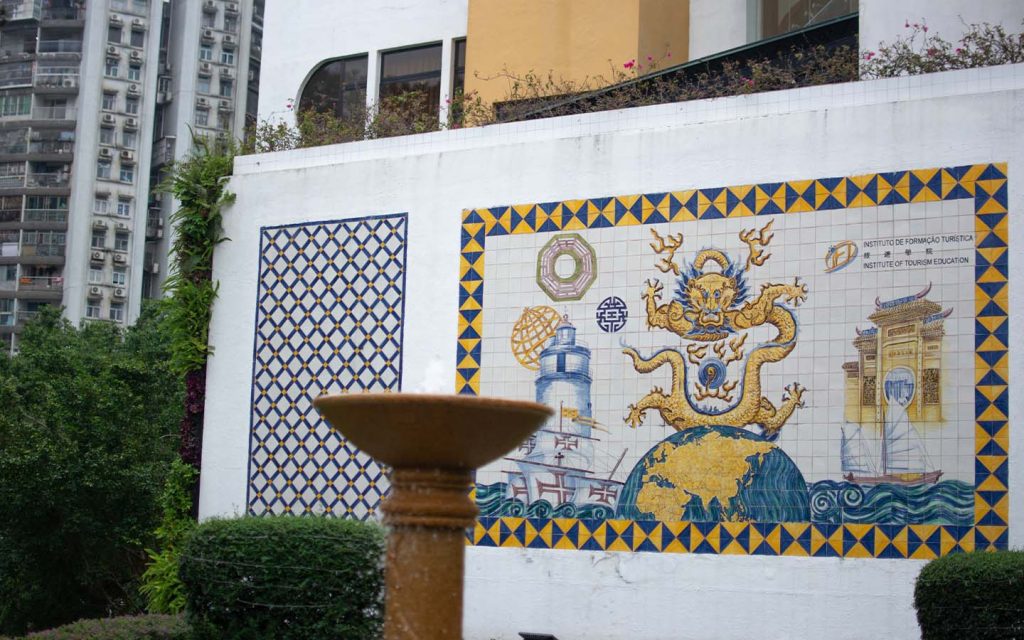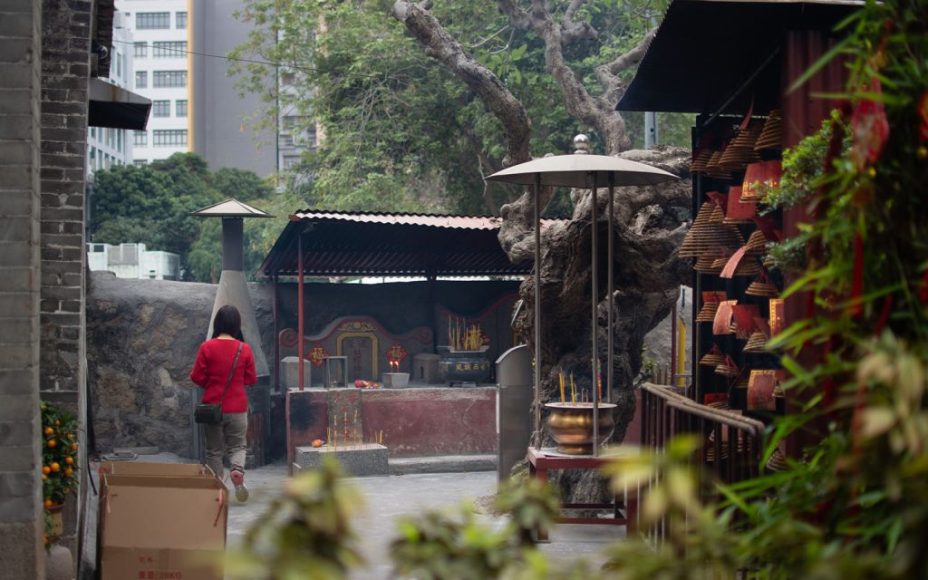What does the average visitor do on a trip to Macao? For sure they’ll make a beeline for the Ruins of St Paul’s, the centuries-old church and beloved symbol of the city. From there, the Old Town’s twisting cobblestone alleyways offer up plenty of historic architecture and fresh-baked egg tarts. It’s also an easy stroll to A-Ma Temple, where one can inhale the evocative incense of an ancient hillside shrine. Many travellers also head south to soak in the relaxed coastal vibes of Coloane Village.
These are all charming, important destinations. The catch? Everyone who visits Macao knows about them. If you want to avoid the masses and experience an off-the-beaten-track side of the city, the government says “head north” – to a district known as Mong Ha.
One of the very first settlements on Macao Peninsula, much of Mong Ha remains residential today. But in between the looming apartment blocks, centuries-old temples rub shoulders with striking feats of Portuguese Modernism. A boutique museum celebrates China’s most consequential composer. Locals buy their fresh produce at Macao’s oldest wet market. There’s even an old fortress hidden in what could be mistaken for a mini jungle.
This article offers a guided tour of Mong Ha, based on the useful tourism map published by Macao’s Cultural Affairs Bureau. Locals may also find something new to explore.
Former Municipal Cattle Stable

Decidedly urban Macao is the last place you’d expect to encounter a roving bovine. And yet, a street sign in Mong Ha expressly forbids cattle from using certain roads. The sign is a throwback to a time when incoming animals were quarantined on Avenida do Almirante Lacerda, in a picturesque ochre complex topped with terracotta tiles that was built in the early 1900s.
Indeed, some roads back then were cattle-friendly: drovers used to herd their charges between the Inner Harbour (where they’d arrive by boat from the mainland), the quarantine zone, and the former municipal slaughterhouse in Barra. All in the name of supplying Macao with fresh meat. In 1987, these services all relocated to a new purpose-built facility in Ilha Verde.
The old quarantine zone, known as the Former Municipal Cattle Stable, now serves a very different purpose. Much of the complex is devoted to art exhibitions and workshops. It’s a place where up-and-coming artists have a chance to display their work in what’s since been transformed into a spacious gallery. It’s where you go to get a handle on Macao’s edgier creative side.

Fittingly, the exhibition space goes by the name of Ox Warehouse. But another animal can often be heard while perusing the artwork, seemingly from very nearby.
That is because there is another side to the old stable. Since 1948, part of the complex has housed the Macao Municipal Kennel. That Art Deco-style building offers a wide range of services for the city’s canine population, including a shelter. Dog lovers may enjoy adding a stopover here after checking out an exhibition. You’ll recognise it by the white statue of a boy embracing his beloved hound out front.
Former civil servants’ homes

Much of Mong Ha’s charm lies in the surprise pops of colour encountered between what are, admittedly, fairly drab apartment blocks. For example, there’s a series of former civil servants’ quarters that shine like jewels along Avenida do Almirante Lacerda, Rua de Francisco Xavier Pereira, Avenida do Coronel Mesquita and Avenida do Conselheiro Ferreira de Almeida.
Built in the flamboyant Português Suave style and painted an almost luminescent minty green, many of these villas have been (or are in the process of being) transformed into artistic and cultural spaces. Venture within to check out what’s on display.
Even the villas that aren’t yet open to the public make for fun photo opportunities. Their character façades and mid-century Macao colour schemes make you feel like you’re on a film set.
Xian Xinghai Memorial Museum

Famed for his Yellow River Cantata and hailed as the ‘People’s Composer’, Xian Xinghai is the focus of one of Macao’s most enchanting museums – housed in a pair of converted civil servants’ apartments. Xian was born in Macao, in 1905, and spent the first six years of his short but incredibly productive life here. He died of lung disease at age 40, in Moscow, then part of the Soviet Union.
The Xian Xinghai Memorial Museum, which opened in 2019, brims with the musician’s personal artefacts (including a precious violin), manuscripts, photographs and carefully curated snippets of his life. Visitors learn that Xian moved from Macao to Singapore to the mainland, where he studied music at Peking University and the newly established National Conservatory of Music (now Shanghai Conservatory of Music). Also that, in 1934, he was the first Chinese student to enrol at the senior composition class of the Conservatoire de Paris.
The composer returned to China in 1935 during Japan’s occupation of Manchuria. During this period, he toured the country with the Shanghai Drama Salvation Society, composing patriotic songs to bring hope to his countrymen. He went to Moscow in 1940, initially working on the score of a documentary. The war thwarted his return to China and Xian wound up spending extended periods in what are now Mongolia and Kazakhstan, where his health broke down due to overwork and malnutrition. Tragically, Xian never made it back to Chinese soil.
The Xian Xinghai Memorial Museum offers fascinating insights into this Macao-born national hero, who created lasting legacies in the face of frequent ill health, poverty and geo-political upheaval.
Mong Ha Hill and fortress

Mong Ha is not all bustling streets and tall buildings. In fact, it is home to one of Macao’s most serene green spaces: Mong Ha Hill. The nature park of over 38,000 square metres boasts rare orchids and butterflies, a playground and a natural rock cave. There’s also a paved nature trail where you’re seldom likely to encounter another human being.
Climbing all the way to the top, past a Roman-style fountain square,
is well worth the effort for a panoramic view of the city. In the mid-19th century, João Maria Ferreira do Amaral was the Portuguese governor of Macao. He recognised the strategic importance and potential defensive value of this particular vista. It inspired him to initiate the construction of a sizable fort atop the hill in 1849, which was completed under a later governor, José Rodrigues Coelho do Amaral, in 1866.
The resulting 650-square-metre complex was surrounded by stone walls and home to 10 canons – with an artillery range that could reach the Border Gate, over 900 metres away. When the fortress was operational, it contained munitions warehouses and a military barracks for Portuguese soldiers from Africa.
The fortress was demilitarised in 1976. Today, the site is well-maintained and provides an interesting glimpse into Macao’s military history. Two canons remain on Mong Ha Hill, one at its summit and the other near the Roman fountain.
The Macao University of Tourism’s student-run inn and restaurant

Perched part-way up Mong Ha Hill, the Macao University of Tourism is the territory’s pre-eminent university to study hospitality and leisure management. It also welcomes visitors, who can – if they wish – spend the night at its teaching hotel, the 20-room Pousada de Mong Ha.
Formerly a military barracks, the boutique pousada (Portuguese for ‘inn’) oozes character. Specifically, the East-meets-West flavour unique to Macao. Expect plenty of mosaics.
If you’re not looking for a place to stay, perhaps you’re after a bite to eat. The university is also home to a one Michelin-star teaching restaurant. It’s a great place to sample Macanese cuisine and Portuguese wine. Saturday’s Macanese buffet is particularly popular here, often accompanied by live music.
Hospitality students make up the bulk of staff at both the inn and restaurant.
Kun Iam Tchai Temple
Kun Iam, the Goddess of Mercy, is one of the most popular deities in Chinese folk religion and she is especially beloved in Macao. Many temples around the territory have been named in her honour, including two on the same Mong Ha street: Avenida do Coronel Mesquita.
The smaller and more rustic of the pair is Kun Iam Tchai Temple, understood to have been constructed by a Chinese shepherd in the 1820s. This temple is striking for the towering twin banyan trees growing in its courtyard.
Kun Iam Tong Temple (Pou Chai Temple)
One of Macao’s oldest and largest temples, the Kun Iam Tong Temple is also called Pou Chai. It consists of three pavilions, each dedicated to a different god (namely, Kun Iam, Tai Hong Pou and Cheong Sau). The current structure is believed to have been built in the early 1600s, with significant renovations completed in 1818 and 1858.
The Kun Iam Tong Temple has played host to a number of important people and events in Macao’s history. In 1844, its picturesque garden was where representatives from China and the US signed the Treaty of Wanghia. The treaty was one of China’s unequal treaties between Qing dynasty rulers and various foreign powers; Wanghia is another name for Mong Ha.
Fast forward a hundred years, and the Cantonese artist Gao Jianfu – associated with the Lingnan School – could be found living in the Kun Iam Tong Temple. Gao fled the mainland in 1938, during World War II, and took up residence in the place of worship, from where he taught painting techniques to locals.
Each year, on the 26th day of the first lunar month, Kun Iam worshippers descend upon the temple for a local Chinese folk custom known as the Opening of Kun Iam’s Treasury. It entails asking Kun Iam for good luck, at a time when it’s believed the deity’s treasury is open.
The Red Market

This brightly coloured market and its iconic clock tower are well known by everyone in Macao. Most locals have perused stalls within the walls of the 88-year-old building at some point in their lives – it is the oldest market in Macao, after all. The Red Market was hailed as a beacon of sanitation when it first opened in 1936.
The market recently reopened after a lengthy period of refurbishment. It again sells an impressive array of vegetables, meat and seafood across its three levels. Here’s the perfect opportunity to see Macao people going about an important part of their daily lives – food shopping – and to gain an appreciation of the quality fresh produce on offer in the city.
Street food and flower vendors also peddle their fragrant offerings just outside its walls. Fancy a steaming bowl of wonton soup, or rice noodles with beef brisket? This is where you’ll find some of the tastiest dishes in Macao.
The Caritas and Red Market libraries

A library may not be a typical tourist attraction, but these two – just a few hundred metres from each other – offer interesting windows into local life. Both are so well-used by the Mong Ha community that they could be described as Macao institutions.
The multi-functional Caritas Library is a haven for not only readers, but musicians. It features four piano rooms, a band room where musos can come to jam, and a space to practise dance. It also sells second-hand books.
The other library is a former post office, located around the corner from its namesake market. Step inside to witness people of all ages reading books, working diligently on computers or flicking through the day’s newspapers.
As a nod to its original function, the Red Market Library boasts one of Macao’s few remaining cylindrical mail boxes – painted fire engine crimson. It is still in operation, why not use it to send a few postcards off to friends and family overseas, telling them of your adventures in Macao?



